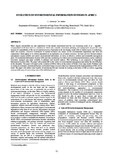Please use this identifier to cite or link to this item:
https://cris.library.msu.ac.zw//handle/11408/1653| Title: | Evolution of environmental information systems in Africa | Authors: | Paradzayi, Charles Rüther, H. |
Keywords: | Environmental information, Environmental Information Systems, Geographic Information Systems, Nolan’s model, Database Management Systems, distributed model | Issue Date: | 2002 | Series/Report no.: | The International Archives of the Photogrammetry, Remote Sensing and Spatial Information Sciences;Vol. XXXIV, Part 6/W6; p. 73-77 | Abstract: | Man’s largely uncontrolled use and exploitation of the natural environment and the ever increasing needs of an – arguably -overpopulated world have lead to a situation in which only scientific assessment, planning and management can provide some measure of sustainability of the use of natural resources. Especially in the developing world with its limited access to technology, funds and expertise, excessive exploitation of natural resources has caused severe environmental degradation and there are communities which appear to be entirely dependent on an exploitative use of natural resources for their survival. Decision-makers and planners require reliable and current environmental information, to arrive at effective, realistic and sustainable management plans. Environmental Information Systems (EIS) provide a technology by which such environmental information can be combined, structured, managed and made available to planners and decision makers. This technology is an expansion of Geographic Information Systems (GIS). The paper will examine EIS in the context of environmental management and outline the role GIS plays in this discipline. The paper will report on the evolution of EIS in Africa in the context of Nolan’s four-stage model. Problems such as technical constraints, institutional barriers and limited human resources that have characterised the implementation of EIS will be noted. The paper will outline some benefits of introducing EIS and conclude by looking at the future of EIS as well as suggesting some possible ways of overcoming some of the inhibiting factors. | URI: | http://www.isprs.org/proceedings/XXXIV/6-W6/papers/paradzayi.pdf http://hdl.handle.net/11408/1653 |
ISSN: | 1682-1750 |
| Appears in Collections: | Research Papers |
Files in This Item:
| File | Description | Size | Format | |
|---|---|---|---|---|
| download.pdf | Full Text | 33.19 kB | Adobe PDF |  View/Open |
Page view(s)
162
checked on Oct 9, 2025
Download(s)
40
checked on Oct 9, 2025
Google ScholarTM
Check
Items in MSUIR are protected by copyright, with all rights reserved, unless otherwise indicated.



